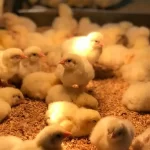The term “chick quality” is a broad term encompassing various aspects, from observable physical characteristics to hidden traits.
The term “chick quality” is a broad term encompassing various aspects, from observable physical characteristics (such as eye color or down) to hidden traits (such as antibody levels, physiological disorders, infections, and nutritional deficiencies).
Many of these visible and hidden traits originate before the eggs are sent from the parent farm to the hatchery.
Environmental and treatment conditions can damage chick quality. Scoring chick quality only reflects their temporary status.
Hatcheries’ legal responsibility usually pertains to the chicks’ status during their first week of life, a very sensitive period and the fastest growth phase for chicks, as a good and calm start determines their final outcome.
Over time, factors related to the parent farm gradually overshadow those from the hatchery, although vertically transmitted diseases that appear in chicks trace back to the hatchery and damage its reputation.
From the hatchery’s perspective, a good one-day-old chick is one that has no physical defects and has the following characteristics:
Strong
Stands on its own feet
Soft and silky down
Active but calm
Clear, round, and open eyes
Soft belly
Well-closed and unnoticeable navel
Not bony
Not dehydrated
Free from wounds or physical defects
These traits are linked to various aspects of the incubator and hatchery processes, with hatchery and incubation conditions influencing their development.
Since scoring these traits can have a wide range, for example (to describe the size of the chick’s belly or its strength), it is better to simplify your evaluation and use a 1 or 0 system. If the trait is appropriate, give it a 1; if inappropriate, give it a 0.
hatcheries
Modern hatcheries handle extensive operations, managing thousands of chicks daily. The quality control system in hatcheries must be comprehensive, fast, easy, and repeatable. This system should compare hatched batches and score the quality of each group.
For instance, the Pasgar© Score system considers five simple traits. Some traits, such as the redness of the chick’s beak, may appear as merely a physical characteristic but could indicate serious underlying issues.
The five traits considered in the Pasgar scoring system are
1- A strong chick, when placed on its back on a non-slip surface, should stand up within 3 seconds. This natural ability indicates the chick’s strength.
2- The chick’s navel should be completely closed and unnoticeable. If the navel is dry and has colored skin but feels dry or raised to the touch, it is not perfect, though better than being bloody or leaking.
In a binary scoring system, both conditions would receive a negative score.
3- The chick’s belly size and hardness test require a sensitive hand and experienced evaluator. This is crucial as the chick’s belly size is mostly related to egg weight loss, and having extra water stored in the belly is beneficial for chicks being transported long distances to farms.
4- Red hocks indicate that the chick has lost a lot of weight (large belly) or has been exposed to excessive heat.
5- Red spots on the chick’s beak or bleeding from the nostrils indicate exposure to excessive heat. A dirty beak signifies metabolic issues related to egg weight loss.
In the Pasgar scoring method, for each negative trait observed, one point is deducted from a total of 12 points. The average score of 50 to 100 chicks reflects the quality of a batch, helping to identify the nature of any problems.
An average score of 9 for a batch indicates good chick quality.
Recommendations
• Decide what to score for quality: the quality of chicks at hatch or the quality of marketable chicks.
• Record, analyze, and maintain quality data for each batch.
• Identify major issues and use this information to adjust the incubation program and hatchery protocol.








